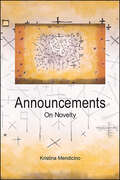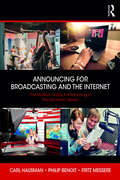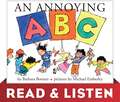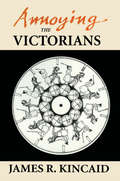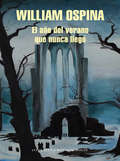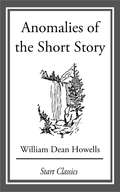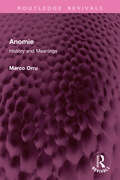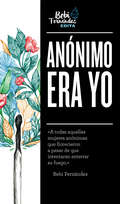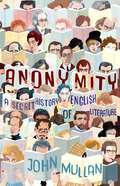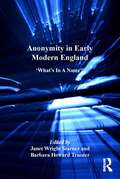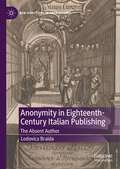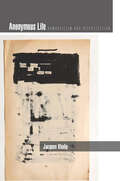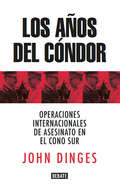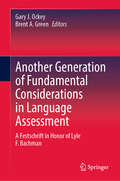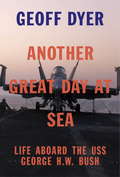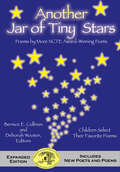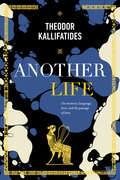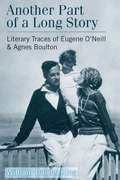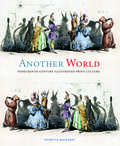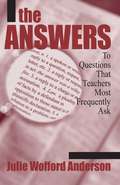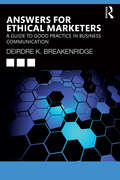- Table View
- List View
Announcements: On Novelty (SUNY series, Intersections: Philosophy and Critical Theory)
by Kristina MendicinoWalter Benjamin claimed that the notion of novelty took on unprecedented importance with the growth of high capitalism in the nineteenth century. In this book, Kristina Mendicino analyzes a selection of canonical texts that reflect profound concern with novelty and its apparent contrary, the eternal return of the same, including Nietzsche's Thus Spoke Zarathustra, Baudelaire's lyric and prose poetry, and Marx and Engels's Communist Manifesto. She also addresses Eternity by the Stars by Louis-Auguste Blanqui, who is less well known and often underestimated in considerations of his significance for revolutionary political theory.Mendicino argues that the notion of a novum cannot be understood without attentiveness to the language of announcement, not least of all because the "new" has always been associated with a particular mode of linguistic performance. Through close readings of emphatically annunciatory texts, she demonstrates how the extreme possibilities of expression that they present through specific citational and rhetorical praxes render the language of announcement overdetermined and anachronistic in ways that exceed any systematic account of historical time and experience. This excess in and through language is precisely what opens hitherto unheard of alternatives for conceiving of historical temporality and political possibility.
Announcing for Broadcasting and the Internet: The Modern Guide to Performing in the Electronic Media
by Carl Hausman Philip G. Benoit Fritz MessereAnnouncing for Broadcasting and the Internet is the standard text for traditional broadcasters and emerging pioneers. While many still pursue careers in traditional fields such as television and radio news announcing, broadcast performance has expanded to Internet radio, podcasting, home voice-over production, and performance on YouTube and other Internet video venues. This text is an update of the classic text Announcing. The practical guide to mastering the techniques and mechanics of broadcast announcing remains, updated to give readers the ability to produce their own portfolio of performance products and get started in the career they want. It covers audio and video editing programs, new streaming media, and how to develop a powerful, consistent, and noteworthy speaking voice.
An Annoying ABC
by Barbara BottnerImagine a preschool classroom with 25 cranky kids and one beleaguered teacher. It only takes one small annoying act from Adelaide to set off a chain reaction of bad behavior. Dexter is drooling, Flora is fuming, Jasper is jeering, Kirby is kicking . . . and before you know it, Stella is stumbling, Todd is tumbling, and Winthrop is weeping. Oh, oh, oh! What will it take to turn this annoying day around? Readers will be amazed and amused to see what happens when Adelaide . . . apologizes.Barbara Bottner and Michael Emberley follow up their bestselling Miss Brooks Loves Books! (and I Don't) with this outrageously funny alphabet book that shows that kindness can be contagious, too.
An Annoying ABC: Read & Listen Edition
by Barbara BottnerImagine a preschool classroom with 25 cranky kids and one beleaguered teacher. It only takes one small annoying act from Adelaide to set off a chain reaction of bad behavior. Kids will want to read and listen along to all of the commotion. Dexter is drooling, Flora is fuming, Jasper is jeering, Kirby is kicking . . . and before you know it, Stella is stumbling, Todd is tumbling, and Winthrop is weeping. Oh, oh, oh! What will it take to turn this annoying day around? Readers will be amazed and amused to see what happens when Adelaide . . . apologizes. Barbara Bottner and Michael Emberley follow up their bestselling Miss Brooks Loves Books (and I Don't) with this outrageously funny alphabet book that shows that kindness can be contagious, too.This ebook includes Read & Listen audio narration.
Annoying the Victorians
by James KincaidWhat happens when bad criticism happens to good people? Annoying the Victorians sets the tradition of critical discourse and literary criticism on its ear, as well as a few other areas. James Kincaid brings his witty, erudite and thoroughly cynical self to the Victorians, and they will never read (or be read) quite the same.
El año del verano que nunca llegó
by William OspinaMe sorprendió que la erupción de un volcán a mediados de 1815, enIndonesia, hubiera sido una de las causas eficientes del nacimiento enOccidente de la moderna leyenda del vampiro y de la pesadilla del serviviente hecho con fragmentos de cadáveres. Sentí el extraño agrado dever cómo se unían en una sola historia, que yo presentía vagamente, lasvidas de Byron y Shelley con la catástrofe de una erupción volcánica enlos mares del sur, con un tsunami en las costas de Bali, con esa nube deazufre y ceniza y cristales volcánicos que ennegreció el cielo de lapenínsula de Indochina y que los monzones se fueron llevando hacia elnorte, desatando el cólera en la India y ahogando muchedumbres en lasinundaciones del Yangtsé y del río Amarillo. Aquella historia unía cosasextremas, abarcaba medio mundo, conjugaba fenómenos geológicos ymeteorológicos con hechos históricos, personajes literarios y criaturasfantásticas. Algo nos hace pensar que este maravilloso libro, como lacriatura Frankenstein, no tuvo infancia, pero también, como el señorvampiro, está fuera del tiempo
Anomalies of the Short Story: From 'Literature and Life'
by William Dean HowellsWilliam Dean Howells (March 1, 1837 - May 11, 1920) was an American realist author and literary critic... In 1858, he began to work at the Ohio State Journal where he wrote poetry, short stories, and also translated pieces from French, Spanish, and German. He avidly studied German and other languages and was greatly interested in Heinrich Heine. In 1860, he visited Boston and met with American writers James Thomas Fields, James Russell Lowell, Oliver Wendell Holmes, Nathaniel Hawthorne, Henry David Thoreau, and Ralph Waldo Emerson. Said to be rewarded for a biography of Abraham Lincoln used during the election of 1860, he gained a consulship in Venice. On Christmas Eve 1862, he married Elinor Mead at the American embassy in Paris. Upon returning to the U.S., he wrote for various magazines, including Atlantic Monthly and Harper's Magazine. From 1866, he became an assistant editor for the Atlantic Monthly and was made editor in 1871, remaining in the position until 1881. In 1869, he first met Mark Twain, which sparked a longtime friendship. Even more important for the development of his literary style--his advocacy of Realism--was his relationship with the journalist Jonathan Baxter Harrison, who in the 1870s wrote a series of articles for the Atlantic Monthly on the lives of ordinary Americans. He wrote his first novel, Their Wedding Journey, in 1872, but his literary reputation took off with the realist novel A Modern Instance, published in 1882, which described the decay of a marriage. His 1885 novel The Rise of Silas Lapham is perhaps his best known, describing the rise and fall of an American entrepreneur in the paint business. His socialviews were also strongly reflected in the novels Annie Kilburn (1888) and A Hazard of New Fortunes (1890). He was particularly outraged by the trials resulting from the Haymarket Riot
Anomie: History and Meanings (Routledge Revivals)
by Marco OrruFirst published in 1987, Anomie examines essential moments of Western thought, tracing the complex concept of anomie. The Greek origin of the term (a-nomia, absence of joy) relates it to the notions of disorder, inequity and anarchy. 20th century sociology has long called into question an over simple dichotomy between law and the absence of law. The book shows that this questioning is not new. It has its roots in Ancient Greek thought and in the founding texts of the Judeo-Christian tradition. It appears in the legal and religious states of the English Renaissance, and in the emerging sociology of 19th century French, where Orrù opposes the collectivism of Durkheim to the individualism of Jean-Marie Guyau. The latter’s thought, little recognized at that time, finds an echo in contemporary sociology, notably in American sociologist R. K. Merton. To write the history of the concept, to account for the fluctuations in meaning that it undergoes in the changing prism of diverse societies, to uncover the subterranean continuities between yesterday and today: this is the aim of the book. This book will be of interest to students of history, sociology, literature and philosophy.
Anónimo era yo
by Varias autorasAhora las voces de Margarita Hickey, Juana Inés de la Cruz, Emilia Pardo Bazán, Rosalía de Castro y Alfonsina Storni suenan más alto que nunca bajo el lápiz inflamable de Bebi. Un libro de la colección «Bebi Edita». Ellas, que escribían escondiendo sus nombres; ellas, que vivían callando; ellas, todas ellas, que fueron sin poder ser y que, aun así, gritaron al mundo su poesía. En las voces de varias poetas encontramos una y otra vez, como una canción demasiado conocida, el miedo, la culpa, la represión. Con su mirada explosiva, Bebi inflama todas las palabras que subyacen en los textos de estas mujeres que se vieron obligadas a vivir a media voz. Bebi empezó incendiando las redes con miles de seguidores. Poco después inflamó libros; Indomable es un éxito de ventas. Ahora llega para editar su propia colección y seguir quemando.
Anonymity: A Secret History of English Literature
by John MullanSome of the greatest works in English literature were first published without their authors' names. Why did so many authors want to be anonymous--and what was it like to read their books without knowing for certain who had written them? In Anonymity, John Mullan gives a fascinating and original history of hidden identity in English literature. From the sixteenth century to today, he explores how the disguises of writers were first used and eventually penetrated, how anonymity teased readers and bamboozled critics--and how, when book reviews were also anonymous, reviewers played tricks of their own in return. Today we have forgotten that the first readers of Gulliver's Travels and Sense and Sensibility had to guess who their authors might be, and that writers like Sir Walter Scott and Charlotte Brontë went to elaborate lengths to keep secret their authorship of the best-selling books of their times. But, in fact, anonymity is everywhere in English literature. Spenser, Donne, Marvell, Defoe, Swift, Fanny Burney, Austen, Byron, Thackeray, Lewis Carroll, Tennyson, George Eliot, Sylvia Plath, and Doris Lessing--all hid their names. With great lucidity and wit, Anonymity tells the stories of these and many other writers, providing a fast-paced, entertaining, and informative tour through the history of English literature.
Anonymity in Early Modern England: 'What's In A Name?'
by Barbara Howard TraisterExpanding the scholarly conversation about anonymity in Renaissance England, this essay collection explores the phenomenon in all its variety of methods and genres as well as its complex relationship with its alter ego, attribution studies. Contributors address such questions as these: What were the consequences of publishing and reading anonymous texts for Renaissance writers and readers? What cultural constraints and subject positions made anonymous publication in print or manuscript a strategic choice? What are the possible responses to Renaissance anonymity in contemporary classrooms and scholarly debate? The volume opens with essays investigating particular texts-poetry, plays, and pamphlets-and the inflection each genre gives to the issue of anonymity. The collection then turns to consider more abstract consequences of anonymity: its function in destabilizing scholarly assumptions about authorship, its ethical ramifications, and its relationship to attribution studies.
Anonymity in Eighteenth-Century Italian Publishing: The Absent Author (New Directions in Book History)
by Lodovica BraidaThis book focuses on the different forms in which authorship came to be expressed in eighteenth-century Italian publishing. It analyses both the affirmation of the “author function”, and, above all, its paradoxical opposite: the use of anonymity, a centuries-old practice present everywhere in Europe but often neglected by scholarship. The reasons why authors chose to publish their works anonymously were manifold, including prudence, fear of censorship, modesty, fear of personal criticism, or simple divertissement. In many cases, it was an ethical choice, especially for ecclesiastics. The Italian case provides a key perspective on the study of anonymity in the European context, contributing to the analysis of an overlooked topic in academic studies.
Anonymous in Their Own Names: Doris E. Fleischman, Ruth Hale, and Jane Grant
by Susan HenryAnonymous in Their Own Names recounts the lives of three women who, while working as their husbands' uncredited professional partners, had a profound and enduring impact on the media in the first half of the twentieth century. With her husband, Edward L. Bernays, Doris E. Fleischman helped found and form the field of public relations. Ruth Hale helped her husband, Heywood Broun, become one of the most popular and influential newspaper columnists of the 1920s and 1930s. In 1925 Jane Grant and her husband, Harold Ross, started the New Yorker magazine.Yet these women's achievements have been invisible to countless authors who have written about their husbands. This invisibility is especially ironic given that all three were feminists who kept their birth names when they married as a sign of their equality with their husbands, then battled the government and societal norms to retain their names. Hale and Grant so believed in this cause that in 1921 they founded the Lucy Stone League to help other women keep their names, and Grant and Fleischman revived the league in 1950. This was the same year Grant and her second husband, William Harris, founded White Flower Farm, pioneering at that time and today one of the country's most celebrated commercial nurseries.Despite strikingly different personalities, the three women were friends and lived in overlapping, immensely stimulating New York City circles. Susan Henry explores their pivotal roles in their husbands' extraordinary success and much more, including their problematic marriages and their strategies for overcoming barriers that thwarted many of their contemporaries.
Anonymous in Their Own Names: Doris E. Fleischman, Ruth Hale, and Jane Grant
by Susan HenryAnonymous in Their Own Names recounts the lives of three women who, while working as their husbands' uncredited professional partners, had a profound and enduring impact on the media in the first half of the twentieth century. With her husband, Edward L. Bernays, Doris E. Fleischman helped found and form the field of public relations. Ruth Hale helped her husband, Heywood Broun, become one of the most popular and influential newspaper columnists of the 1920s and 1930s. In 1925 Jane Grant and her husband, Harold Ross, started the New Yorker magazine. Yet these women's achievements have been invisible to countless authors who have written about their husbands. This invisibility is especially ironic given that all three were feminists who kept their birth names when they married as a sign of their equality with their husbands, then battled the government and societal norms to retain their names. Hale and Grant so believed in this cause that in 1921 they founded the Lucy Stone League to help other women keep their names, and Grant and Fleischman revived the league in 1950. This was the same year Grant and her second husband, William Harris, founded White Flower Farm, pioneering at that time and today one of the country's most celebrated commercial nurseries. Despite strikingly different personalities, the three women were friends and lived in overlapping, immensely stimulating New York City circles. Susan Henry explores their pivotal roles in their husbands' extraordinary success and much more, including their problematic marriages and their strategies for overcoming barriers that thwarted many of their contemporaries.
Anonymous Life: Romanticism and Dispossession
by Jacques KhalipRomanticism is often synonymous with models of identity and action that privilege individual empowerment and emotional autonomy. In the last two decades, these models have been the focus of critiques of Romanticism's purported self-absorption and alienation from politics. While such critiques have proven useful, they often draw attention to the conceptual or material tensions of romantic subjectivity while accepting a conspicuous, autonomous subject as a given, thus failing to appreciate the possibility that Romanticism sustains an alternative model of being, one anonymous and dispossessed, one whose authority is irreducible to that of an easily recognizable, psychologized persona. In Anonymous Life, Khalip goes against the grain of these dominant critical stances by examining anonymity as a model of being that is provocative for writers of the era because it resists the Enlightenment emphasis on transparency and self-disclosure. He explores how romantic subjectivity, even as it negotiates with others in the social sphere, frequently rejects the demands of self-assertion and fails to prove its authenticity and coherence.
Los años del Cóndor
by John DingesLa investigación definitiva sobre la organización criminal transfronteriza que azotó a Latinoamérica durante la década de los setenta. Ocho gobiernos latinoamericanos liderados por Chile y Argentina formaron una alianza militar conocida como “Operación Cóndor” en los setenta. ¿Su objetivo? Cruzar las fronteras para llevar a cabo secuestros, asesinatos, torturas y otros crímenes en países del Cono Sur, Norteamérica y Europa. Esta temprana modalidad de “guerra contra el terror”, de la cual la CIA y el propio gobierno estadounidense fueron cómplices, muy pronto fue una decisión contraproducente, ya que uno de los asesinatos internacionales se llevó a cabo en las calles de Washington D.C. Aclamado por los principales medios de prensa internacionales tanto por su contribución a la memoria histórica como por su insuperable periodismo de investigación, Los años del Cóndor revela, con rigurosidad y detalle, los personajes y el engranaje de los sistemas de represión transfronteriza sin precedente de América Latina. Su autor, el premiado y reconocido periodista John Dinges, quien también fue secuestrado e interrogado en Villa Grimaldi, entrevistó a protagonistas de esta historia, además de examinar miles de documentos recientemente desclasificados. Los últimos juicios de los militares responsables y los documentos liberados por Estados Unidos en 2019 han permitido al autor adentrarse en las operaciones militares y relatar las trágicas y desconocidas historias humanas de las víctimas, cuyos nombres se presentan aquí por primera vez de forma completa. Un libro contundente y al mismo tiempo íntimo sobre esa oscura época.
Another Generation of Fundamental Considerations in Language Assessment: A Festschrift in Honor of Lyle F. Bachman
by Gary J. Ockey Brent A. GreenThis edited book is a collection of papers, written by language assessment professionals to reflect the guidance of Professor Lyle F. Bachman, one of the leading second language assessment experts in the field for decades. It has three sub-themes: assessment of evolving language ability constructs, validity and validation of language assessments, and understanding internal structures of language assessments. It provides theoretical guidelines for practical language assessment challenges. Chapters are written by language assessment researchers who graduated from the University of California, Los Angeles, where Professor Bachman trained them including the book editors.
Another Great Day at Sea: Life Aboard the USS George H.W. Bush
by Geoff DyerFrom a writer "whose genre-jumping refusal to be pinned down [makes him] an exemplar of our era" (NPR), a new book that confirms his power to astound readers. As a child Geoff Dyer spent long hours making and blotchily painting model fighter planes. So the adult Dyer jumped at the chance of a residency aboard an aircraft carrier. Another Great Day at Sea chronicles Dyer's experiences on the USS George H.W. Bush as he navigates the routines and protocols of "carrier-world," from the elaborate choreography of the flight deck through miles of walkways and hatches to kitchens serving meals for a crew of five thousand to the deafening complexity of catapult and arresting gear. Meeting the Captain, the F-18 pilots and the dentists, experiencing everything from a man-overboard alert to the Steel Beach Party, Dyer guides us through the most AIE (acronym intensive environment) imaginable. A lanky Englishman (could he really be both the tallest and the oldest person on the ship?) in a deeply American world, with its constant exhortations to improve, to do better, Dyer brilliantly records the daily life on board the ship, revealing it to be a prism for understanding a society where discipline and conformity, dedication and optimism, become forms of self-expression. In the process it becomes clear why Geoff Dyer has been widely praised as one of the most original--and funniest--voices in literature. Another Great Day at Sea is the definitive work of an author whose books defy definition.From the Hardcover edition.
Another Jar of Tiny Stars: Poems by More NCTE Award-Winning Poets
by Deborah WootenA Jar of Tiny Stars is one of the most popular poetry books from WordSong. This new edition is now expanded and includes the work of the latest five winners of the National Council of Teachers of English Award for Poetry for Children. By turns silly and wise, playful and thought-provoking, the poems in this collection were chosen by young readers as their favorites among those written by NCTE Award winners. New to this collection are works from Eloise Greenfield, Nikki Grimes, Mary Ann Hoberman, Lee Bennett Hopkins, and X. J. Kennedy. Rounding out the collection are poems by Arnold Adoff, John Ciardi, Barbara Esbensen, Aileen Fisher, Karla Kuskin, Myra Cohn Livingston, David McCord, Eve Merriam, Lilian Moore, and Valerie Worth.
Another Life: A Memoir of Other People
by Michael KordaThe life story of one who eventually becomes successful in the world of book authoring and publishing.
Another Life: On Memory, Language, Love, and the Passage of Time
by Theodor Kallifatides Marlaine DelargyA rewarding philosophical essay on memory, language, love, and the passage of time, from a Greek immigrant who became one of Sweden’s most highly respected writers“Nobody should write after the age of seventy-five,” a friend had said. At seventy-seven, struggling with the weight of writer’s block, Theodor Kallifatides makes the difficult decision to sell the Stockholm studio where he diligently worked for decades and retire. Unable to write, and yet unable to not write, he travels to his native Greece in the hope of rediscovering that lost fluidity of language. In this slim memoir, Kallifatides explores the interplay of meaningful living and meaningful work, and the timeless question of how to reconcile oneself to aging. But he also comments on worrying trends in contemporary Europe—from religious intolerance and prejudice against immigrants to housing crises and gentrification—and his sadness at the battered state of his beloved Greece. Kallifatides offers an eloquent, thought-provoking meditation on the writing life, and an author’s place in a changing world.
Another Part of a Long Story: Literary Traces of Eugene O'Neill and Agnes Boulton
by William King"An engrossing biography about the marital breakdown of a major literary figure, of particular interest for what it reveals about O'Neill's creative process, activities, and bohemian lifestyle at the time of his early successes and some of his most interesting experimental work. In addition, King's discussion of Boulton's efforts as a writer of pulp fiction in the early part of the 20th century reveals an interesting side of popular fiction writing at that time, and gives insight into the lifestyle of the liberated woman. " ---Stephen Wilmer, Trinity College, Dublin Biographers of American playwright Eugene O'Neill have been quick to label his marriage to actress Carlotta Monterey as the defining relationship of his illustrious career. But in doing so, they overlook the woman whom Monterey replaced---Agnes Boulton, O'Neill's wife of over a decade and mother to two of his children. O'Neill and Boulton were wed in 1918---a time when she was a successful pulp novelist and he was still a little-known writer of one-act plays. During the decade of their marriage, he gained fame as a Broadway dramatist who rejected commercial compromise, while she mapped that contentious territory known as the literary marriage. His writing reflected her, and hers reflected him, as they tried to realize progressive ideas about what a marriage should be. But after O'Neill left the marriage, he and new love Carlotta Monterey worked diligently to put Boulton out of sight and mind---and most O'Neill biographers have been quick to follow suit. William Davies King has brought Agnes Boulton to light again, providing new perspectives on America's foremost dramatist, the dynamics of a literary marriage, and the story of a woman struggling to define herself in the early twentieth century. King shows how the configuration of O'Neill and Boulton's marriage helps unlock many of O'Neill's plays. Drawing on more than sixty of Boulton's published and unpublished writings, including her 1958 memoir,Part of a Long Story, and an extensive correspondence, King rescues Boulton from literary oblivion while offering the most radical revisionary reading of the work of Eugene O'Neill in a generation. William Davies King is Professor of Theater at the University of California, Santa Barbara, and author of several books, most recentlyCollections of Nothing, chosen by Amazon. com as one of the Best Books of 2008. Illustration: Eugene O'Neill, Shane O'Neill, and Agnes Boulton ca. 1923. Eugene O'Neill Collection, Beinecke Rare Book and Manuscript Library, Yale University.
Another World: Nineteenth-Century Illustrated Print Culture
by Patricia MainardiThe remarkable story of the stylistic, cultural, and technical innovations that drove the surge of comics, caricature, and other print media in 19th-century Europe Taking its title from the 1844 visionary graphic novel by J. J. Grandville, this groundbreaking book explores the invention of print media—including comics, caricature, the illustrated press, illustrated books, and popular prints—tracing their development as well as the aesthetic, political, technological, and cultural issues that shaped them. The explosion of imagery from the late 18th century to the beginning of the 20th exceeded the print production from all previous centuries combined, spurred the growth of the international art market, and encouraged the cross-fertilization of media, subjects, and styles. Patricia Mainardi examines scores of imaginative and innovative prints, focusing on highly experimental moments of discovery, when artists and publishers tested the limits of each new medium, creating visual languages that extend to the comics and graphic novels of today. Another World unearths a wealth of visual material, revealing a history of how our image-saturated world came into being, and situating the study of print culture firmly within the context of art history.
The Answers: To Questions That Teachers Most Frequently Ask
by Julie Wofford AndersonJulie Wofford Anderson, teacher and educational consultant, uses her years on the front lines to answer the most commonly asked real-life questions of pre-service as well as first and second-year teachers. Her experience supervising teachers and training student teachers provides her with the unique ability to have field-tested answers ready before the questions are asked!Sample questions include: What can I do to command respect from my students? When am I supposed to do all this stuff and teach as well? What are rubrics exactly? How can I establish good discipline in my classroom? What do I do with unreasonable demands by vocal and difficult parents?This practical "been there, done that" approach to overcoming the most common problems facing new teachers today will save time and effort and put you on the path to success. A must for every new and pre-service teacher in K¬-12.
Answers for Ethical Marketers: A Guide to Good Practice in Business Communication
by Deirdre K. BreakenridgeWith recent changes in technology, media, and the communication landscape, the journey to ethics has become more complicated than ever before. This book aims to answer ethical questions, from applying ethics and sound judgment through your organization and communication channels to taking your ethics and values into every media interview. With the understanding of how personal and professional ethics align, business leaders, managers, and students will maneuver their way around this new landscape showcasing their values in ethical conduct. This book is divided into eight important areas based on where and why a breakdown in ethical behavior is likely to occur, and delivers advice from experts on the frontlines of business communications who know what it means to face the inherent changes and challenges in this field. With more than 80 questions and answers focused on guiding marketing, PR and business professionals, readers will uncover situations where ethics are challenged, and their values will be tested. This straightforward Q&A guidebook is for professionals who realize ethics are a crucial part of decision-making in their communications and who want to maintain trust with the public and their positive brand reputations in business. Readers will receive answers to pressing ethical questions to help them apply best practice guidelines and good judgment in their own situations, based on the stories, theories, and practical instruction from the author’s 30 years of experience as well as the thought leaders featured in this book.
